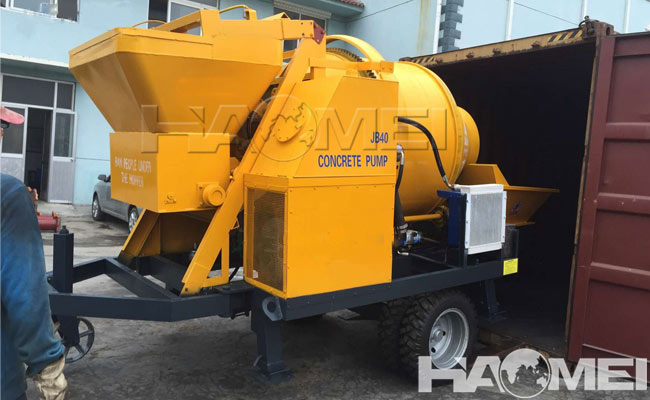Diesel Concrete Pump With Mixer Machine
Diesel concrete pump with mixer machine, also commonly known as diesel concrete mixer pump, are widely used in construction projects, infrastructure construction and other occasions where concrete construction is required. The mixing capacity is usually between 0.5 cubic meters and 3 cubic meters, with 1 cubic meter and 1.5 cubic meter models being common. The pumping capacity is generally between 20 cubic meters/hour and 50 cubic meters/hour. The maximum pumping pressure is usually between 8 MPa and 25 MPa. The diesel engine power is generally between 60 kW and 150 kW.

Working principle of diesel concrete pump with mixer machine:
- Power system:
With diesel engine as the core power source, it outputs high torque, provides power for the mixing system and pumping system, and can work stably in an environment without power supply or unstable power supply.
- Mixing system:
It is mainly composed of a mixing drum and mixing blades. The mixing drum is usually welded from steel plates. The internal spiral blades rotate under the drive of the diesel engine through the transmission system to achieve uniform mixing of cement, sand, water and other additives. There are two mixing methods: self-falling and forced. The self-falling type relies on gravity to mix the materials, while the forced type uses mechanical forced mixing, which has a better mixing effect and can meet different concrete mixing needs.
- Pumping system:
Use pressure to continuously transport the mixed concrete along the pipeline. Its key components include hydraulic pumps, hydraulic valves and S-tube valves. Driven by the diesel engine, the hydraulic pump presses the hydraulic oil into the hydraulic system to push the piston in the concrete cylinder to move, thereby sucking the concrete from the hopper and pumping it to the pouring position through the delivery pipe. The optimized design of the S-tube valve can make the concrete pumping smoother and reduce blockage.
Structural composition of diesel concrete mixer pump:
- Diesel engine:
It is the power source of the equipment. The power range varies according to the equipment model and work requirements, generally ranging from tens of kilowatts to hundreds of kilowatts.
- Mixing device:
Including mixing drum, mixing blades, transmission device, etc. Common mixing drums are drum type and double-horizontal shaft type. The double-horizontal shaft mixing system has higher mixing efficiency and better mixing quality.
- Pumping device:
It is composed of pump body, concrete cylinder, piston, S-tube valve, delivery pipe, etc. The pump body is the core of the pumping system. The concrete cylinder is used to contain and push concrete. The piston reciprocates in the concrete cylinder under the action of hydraulic pressure. The S-tube valve is responsible for switching the flow direction of concrete, and the delivery pipe delivers concrete to the designated position.
- Hydraulic system:
It is composed of oil pump, hydraulic valve group, hydraulic cylinder, hydraulic motor, etc. The driving and control of the mixing device and pumping device are realized through the pressure transmission of hydraulic oil.
- Electrical control system:
It adopts control elements such as programmable controller (PLC) to accurately control the start, stop, mixing speed, pumping speed, reversing and other actions of the equipment. Some equipment also comes with wireless remote control as standard, which is more flexible and convenient to operate.
- Chassis and mobile device:
Some models are equipped with tires or trailer design, which is convenient for transfer between different construction sites and improves the mobility and utilization of equipment.
Features of diesel concrete pump with mixer machine:
- Strong mobility:
It has its own diesel engine and mobile device, and does not need to rely on external power supply and complex transportation equipment. It can be quickly moved to different construction sites, and is suitable for various remote areas or construction sites with insufficient power supply.
- Function integration:
The concrete mixing and conveying functions are integrated into one, which reduces the equipment investment and floor space of the construction site, improves construction efficiency, and reduces construction costs.
- Reliable performance:
It adopts mature hydraulic technology and high-quality components, such as the imported Kawasaki main oil pump, which has high stability and reliability, and can pump high-grade concrete stably in harsh environments for a long time.
- Strong conveying capacity:
It can convey concrete with larger aggregate particle size, with a wide range of displacement, and the maximum theoretical conveying capacity can reach tens of cubic meters or even hundreds of cubic meters per hour, which can meet the concrete conveying needs of projects of different scales.
- Easy operation:
Equipped with advanced electrical control system and humanized operation interface, it is simple and easy to learn. Only one person is needed to complete the operation of the equipment, which reduces the technical requirements for operators.
Application areas of diesel concrete pump with mixer machine:
- Civil construction:
Such as foundation pouring, floor concrete pouring, etc. of residential, commercial buildings, office buildings, etc., the mixed concrete can be directly pumped to the pouring location to improve construction efficiency and quality.
- Roads and bridges:
Used for concrete laying of road base, concrete pouring of bridge piers, abutments, beams and other parts, which can ensure the continuous supply and uniformity of concrete and ensure the quality of the project.
- Water conservancy projects:
In the construction of water conservancy projects such as dams, canals, and hydropower stations, concrete can be transported to high or distant construction sites to meet the requirements of water conservancy projects for concrete construction.
- Tunnel projects:
Concrete construction of tunnel linings, inverts and other parts, diesel concrete pumps with mixers can flexibly operate in the narrow space of the tunnel, providing efficient concrete transportation solutions for tunnel construction.

